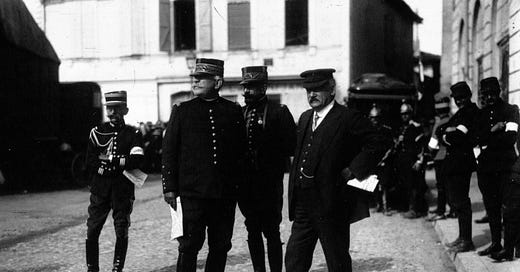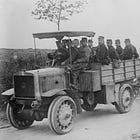The Father of the 'Régiments d'Artillerie Lourde'
The Phantom Batteries of Plan XVII (Part VII)
Recent scholarship pays scant attention to the five heavy artillery regiments of Plan XVII. When they are mentioned at all, they are mentioned in passing – usually to underscore the great superiority in mobile heavy artillery enjoyed by the German Army at the start of World War I.[23] The great exception to this general rule is provided by the admirably detailed discussion of mobile heavy artillery and light field howitzers in Pyrrhic Victory. In this eight-page treatment, Robert Doughty contrasts the success that Joffre enjoyed in other realms with his failure to provide adequate heavy artillery to French field armies, concluding that Joffre ‘…never used his energy and his authority to improve artillery in the way he used them to change French doctrine.’[24]
From the perspective of simple arithmetic, this argument that Joffre did not do all that he could have done to mobile heavy artillery to French field armies is unassailable. In addition to creating the five heavy artillery regiments, the cadre law of 15 April 1914 also authorized a considerable increase (from twenty to thirty) in the number of horse artillery batteries serving with cavalry divisions, a respectable increase in the number of mountain batteries (all three of which of which were formed for service in North Africa) and a slight increase in the number of field batteries (both of which were also destined for the Maghreb). Had Joffre decided to devote to mobile heavy artillery the resources employed in the creation of these sixteen ‘light’ batteries, he would not have had to delay the formation of the last three batteries of the 2nd Heavy Artillery Regiment. In addition to this, he could have formed a sixth heavy artillery regiment. Joffre also had the option of converting some of the reserve field batteries formed upon mobilization into mobile heavy batteries.[25] (This was how Joffre’s predecessor, General Victor Michel, planned to provide the vast majority of the 126 mobile heavy batteries called for in his ill-fated ‘demi-brigade’ proposal of 1911.)[26]
This said, it is unfair to condemn Joffre for failing to put all of his eggs in one basket. During the three years that preceded the outbreak of World War I Joffre set in motion a number of reforms. Some of these, such as the strengthening of mountain troops (whether infantry, artillery or engineers) and cavalry divisions, served to bolster the covering forces that protected France from a surprise attack carried out by the peacetime German Army. Others, such as the increase in the number of zouave battalions, the introduction of conscription to Algeria and the increase in the number of artillery units stationed in North Africa, enhanced the ability of the Armée d’Afrique to contribute forces to the defense of France. A third set of reforms, which included an expansion of the engineer arm of the French Army, the creation of signals units that specialized in radio communications and the establishment of an air corps, provided organizational homes for new technologies. The wisdom of undertaking these reforms, moreover, is evident in the events of the first few months of World War I. The German Army began the war with a surprise attack against the Belgian fortress of Liège – the very kind of attaque brusquée that the covering forces of the French Army were designed to prevent. Contingents provided by the expanded Armée d’Afrique prevented the operational disasters of the third week of August of 1914 from becoming a strategic catastrophe. Likewise, the new airplane squadrons played a decisive role in the Battle of the Marne.
It is also unfair to condemn Joffre for his inability to predict exactly when the next war with Germany would break out. Had he known, in the autumn of 1913 or the spring of 1914, that World War I would begin on 1 August 1914, he would been able to scrap all projects with long-term payoffs in order to focus on schemes that promised immediate gratification. In particular, he might have diverted resources from the effort to strengthen cavalry divisions – which would not have produced operationally significant results until 1916 or so – in order to improvise a large number of mobile heavy batteries. In the absence of such clairvoyance, however, it made perfect sense for Joffre to have struck a balance between near-term rapid expansion and systematic development, particularly since the hallmark of his reform efforts was an increase in the quality of all wartime units.. Where artillery was concerned, moreover, it was perfectly reasonable for Joffre to synchronize the creation of new batteries with the availability of modern weapons. Thus, one reason for creating so many new horse artillery batteries in the spring of 1914 was the impending delivery of a large number of thoroughly modern horse artillery guns.[27]
It is often said that hindsight is the enemy of the realistic appreciation of the decisions made in the course of a battle or campaign. What is true for operations is also true for institutional reform. The decisions that Joseph Joffre took in the three years that preceded the outbreak of World War I were taken in real time, against the backdrop of a recent revolution in military technology (heavy guns and howitzers with on-carriage recoil mechanisms), several ongoing revolutions in military technology (powered aircraft, motor transport, super-heavy siege artillery and radio), unstable domestic politics (seven ministers of war in three years), and a volatile international environment. The problems faced by the French Army during these years, moreover, were legion. In addition to overcoming a decade’s worth of neglect in the realm of mobile heavy artillery, Joffre had to deal with the complete absence of modern light field howitzers, cavalry that could not ride (let alone conduct a proper operational reconnaissance), a shortage of qualified non-commissioned officers, inadequate covering forces, and the impending block obsolescence of the existing stock of infantry rifles. In addition to this, Joffre had to deal with several well-placed artillery officers who were categorically opposed to the adoption of any mobile artillery piece that was larger than a 75mm field gun.[28] With these things in mind, the wonder is not that Joffre provided so little mobile heavy artillery to the forces that executed Plan XVII, but that he was able to provide so much.
Notes:
[23] The most important overviews of Plan XVII to appear since World War II can be found in Henri Contamine, La Revanche (Paris: Berger-Levrault, 1957); David B. Ralston, The Army of the Republic, (Cambridge: MIT Press, 1967); S.R. Williamson, ‘Joffre Reshapes French Strategy, 1911-1913’, in Paul Kennedy, ed., War Plans of the Great Powers, (London: George Allen and Unwin, 1979); Douglas Porch, The March to the Marne, (Cambridge: Cambridge University Press, 1981); Jack Snyder, The Ideology of the Offensive, (Ithaca: Cornell University Press, 1984); and Hew Strachan, The First World War (Oxford: Oxford University Press, 2001), Vol. 1, To Arms.
[24] Robert Doughty, Pyrrhic Victory, French Strategy and Operations in the Great War, (Cambridge: Harvard University Press, 2005), p. 33.
[25] As the supply of Rimailho howitzers was exhausted by the formation of the three new Rimailho batteries of the 5th Heavy Artillery Regiment, any additional mobile heavy batteries would have had to make do with heavy ordnance of other sorts, whether Baquet howitzers, 120mm heavy guns or 220mm medium siege howitzers.
[26] A verbatim copy of the first version (dated 10 February 1911) of Michel’s ‘demi-brigade’ proposal can be found in Alexandre Percin, Les Erreurs du Haut Commandement, (Paris: Albin Michel, 1919), pp. 41-49. A slightly different version, dated 15 June 1911, is reprinted in Les Armées Françaises dans la Grande Guerre, (Paris: Imprimerie National, 1924), Tome I, Volume 1, Annex 4. While neither version of the proposal contains an explicit call for the conversion of field batteries into mobile heavy batteries, such a transformation provides the simplest explanation for the otherwise mysterious disappearance of five field batteries from each of army corps mentioned in the plan as well as the equally mysterious appearance of five mobile heavy batteries in each formation of that type.
[27] Baquet, Souvenirs, pp. 36-37.
[28] The best English-language account of bureaucratic resistance to the adoption of modern heavy artillery in the French Army is Robert Ripperberger, ‘The Development of French Artillery for the Offensive, 1890-1914’, The Journal of Military History, October 1995.
This is the last post in The Phantom Batteries of Plan XVII. For links to the other posts in this series, please make use of the following aggregator:
To Subscribe, Support, or Share:
.







